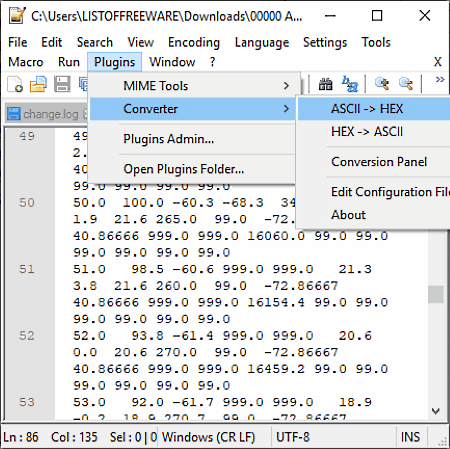
ascii to hex converter
Decoding the Digital World: ASCII to Hex Conversion

Source: lambdatest.com
Ever wondered how your computer speaks to the internet? It uses a secret code, and understanding ASCII to hex conversion is like learning that code! It's like learning a secret language between your phone and your computer, so much cooler, isn't it!
Understanding ASCII
ASCII (American Standard Code for Information Interchange) is a system that assigns numbers to each letter, number, and symbol. Think of it as a super-duper dictionary for computers, showing them exactly what each symbol is supposed to mean, and how it will be expressed in bits and bytes.
- Each letter, symbol, and even spaces and punctuation get their unique code, like having unique names for everyone on the playground.
- This is fundamental! This conversion is crucial for all data transmission between computer systems. "Every little detail matters, people!".

Source: listoffreeware.com
Why ASCII?
ASCII is used because computers "don't" understand letters; they only know numbers. The ASCII code acts like a translator, showing your computer which number represents a particular letter, like how the translation system work in language apps to decode different languages. This is super cool!
- A simple 'A' becomes the number 65.
- Crucially, numbers are expressed by bits. (The binary equivalent of ones and zeros is crucial, it's called binary code or simply binary)
What is Hexadecimal?
Hexadecimal (often abbreviated as "hex") is a base–16 numbering system. It uses 16 symbols, digits from 0-9 and then six more: A, B, C, D, E, F, which stand for 10, 11, 12, 13, 14, and 15 in our decimal system. It's a lot simpler, easier, and compact way to express information than the huge, raw numbers associated with binary!
- Why use it? Hex is compact; 1 hex character can represent 4 bits of data, compared to binary (2 bits). This means hex code makes data easier to read!
The Relationship
Now, let's see how ASCII and Hex fit together! This is the cool part! Converting ASCII to hex is like finding a hidden code and understanding how this code expresses things digitally.

Source: theorycircuit.com
Converting ASCII to Hex
This is like deciphering a hidden message.
Step-by-Step Conversion
- Find the ASCII value: First, you need to locate the character's numerical equivalent in the ASCII chart (your cheat-sheet), similar to when you look up a word in the dictionary. Look up the symbol!
- Convert to binary: Convert the ASCII value to its 8-bit binary equivalent, making sure you fill any gaps in binary. Every character from your code must have 8-bit numbers assigned. Example: 'A'(ASCII: 65) would convert to 01000001. That 8-digit code is so important for this!
- Group into 4-bit chunks: Group the 8-bit binary code into 4-bit chunks.
- Convert to hex: Now, directly convert these 4-bit binary numbers to their corresponding hex values. Looking into your cheat sheet is extremely useful in this phase; it has the chart which you can read up. You have the binary equivalents, and next to it is hex, like magic. Check your reference material.
- Remember to express this in hexadecimal. A hex chart is a quick-look chart that explains these processes with binary expressions in an orderly manner
Example: Convert 'B' (ASCII: 66) to hex.
- ASCII value = 66
- Binary = 01000010
- 4-bit chunks = 0100 and 0010
- Hex equivalents = 4 and 2
- Final hex value = 42
Handy Tips
- Use online converters for fast conversions (these can also tell you how binary and other related digital components come into play when transferring messages!) (This really comes handy sometimes)
- You'll be better off memorizing the binary codes corresponding to hex and decimal equivalents of the common alphabets (like those you see used regularly).
- Use reference materials like charts and books on this process so you can just read the chart directly and save time
Practice!

Source: ytimg.com
- Try converting 'c', 'h', 'e', and 'r' (in order).
- Now, try converting any ASCII characters that you use frequently. Try "I love dogs". (Note that spaces have their ASCII equivalents too).
Where is This Used?
- Encoding messages digitally: You are reading these characters in your web browser through some coding techniques related to the language being used. That information was transferred to you, and it must be translated through processes like these for you to view! The translation happens through a digital connection and servers. This is happening to your every message.
- Working with text files: This coding translates text into digital formats in files, which will later be translated when read back up in a text document!
- Computer memory management. Computers can directly handle binary representations because these bits translate to the presence/absence of certain states in a microelectronic environment.
- Networking and communication: Computers have standards so they can speak and interact. It must transfer codes, information through the internet that everyone can comprehend. They rely heavily on translating, representing symbols via these code systems (like converting hex).
FAQs
Q: Why not just use binary directly?
A: While binary is the fundamental language of computers, hex provides a more readable, and organized way to represent binary code. Binary becomes hard to follow and review with thousands of numbers. Just imagine if every line in your project involved only one or two words. Imagine coding like that (writing a long text) in only one and zeroes! Hex code is extremely useful when working in huge digital projects.
Q: Are there any other ways of representation that I should be looking at?
A: Sure! There are different, similar coding conventions in practice but fundamentally hex, ASCII, and binary forms are crucial building blocks. The process still applies.

Source: discourse-cdn.com
Conclusion
ASCII to hex conversion isn't just a theoretical concept; it forms the base of how our devices "talk" and handle information in the modern world. With a basic understanding, you can grasp how your electronic devices connect, interact, and understand each other! It helps to be aware of this digital background.


